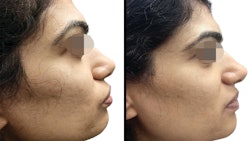Patient selection key to PRP success
Explore the science behind PRP.

Platelet-rich plasma (PRP), a concentrate from whole blood, is widely discussed as one of the newest potential tools for skin and hair repair and also one of the most widely promoted dermatologic techniques on social media.
“There are people out there saying all you need is someone’s blood and the right commercial system and you’re in business,” said session director Omer Ibrahim, MD, FAAD, during yesterday’s new session, F019 – Platelet Rich Plasma. Dr. Ibrahim is founder of Chicago Cosmetic Surgery and Dermatology. “As dermatologists, we need to cut through the misinformation and get to the science behind PRP.”
During the session, Dr. Ibrahim described what is known of the mechanism of action for PRP, how to prepare it, and how to select the most appropriate patients and administer PRP to the best effect.
True blood?
Long used in cardiac surgery, oral surgery, orthopedics, and other fields, PRP is a serum concentrate that contains a high volume of platelets and platelet-derived growth factors including vascular endothelial growth factor, epithelial growth factor, transforming growth factor beta, and insulin-like growth factor. These components promote stem cell regeneration, soft tissue remodeling, mitogenesis, and cell differentiation leading to cellular proliferation, collagen synthesis, and blood vessel formation that aid in the improvement of skin health and the appearance of scarring, photoaging, fine lines, and wrinkles as well as stimulating hair growth.
PRP is usually derived from 10 to 20 mL of autologous blood that is centrifuged into three layers: red blood cells, platelet-poor plasma, and platelet-rich plasma. Depending on the system, the PRP may or may not be treated with thrombin to activate the platelets.
Less invasive, but more labor-intensive
“It is an autologous process, which is an advantage for people who don’t like medications and might not want to use fillers in their skin,” said session presenter Natasha Mesinkovska, MD, PhD, FAAD, associate professor of dermatology at the University of California Irvine School of Medicine and chief scientific officer for the National Alopecia Areata Foundation. “However, it is laborious to prepare and can be painful to administer.”
And the effects are difficult to predict. The platelet concentration and growth factor profile in the final product depends largely on the whole blood from which each PRP dose is made. Platelet concentration and quality are highly variable, Dr. Ibrahim noted. Platelet integrity can vary by age, general health, recent injuries, medications, renal function, and other factors.
Single spin vs. double spin
“Whatever the brand, you’re really looking at two approaches, single spin and double spin,” Dr. Ibrahim said. “As the names suggest, single spin goes through the centrifuge once, double spin two times.”
Single spin systems can yield PRP concentration anywhere from 1.5 to five times whole blood, he explained. Single spin systems require less whole blood, are easier to use, and less subject to human error.
Double spin systems can yield platelet concentrations up to nine times that of whole blood. Double spin systems require more whole blood, Dr. Ibrahim added, may include greater numbers of red blood cells, granulocytes, leukocytes, and other unwanted components, and are more subject to human error during the more complex production process.
Treatment response varies
“The same patient may not have the same response to the procedure from one time to the next,” Dr. Mesinkovska told attendees. “That makes it very difficult to do studies and the variability of human blood makes it even more difficult to do well-controlled studies because every PRP treatment is unique.”
There are no standards for PRP at this point, Dr. Mesinkovska cautioned attendees, and every system produces a unique product. She said she uses PRP primarily to stimulate hair growth and has found that patient selection is key to success.
“From studies and my own experience, I know that treating earlier in hair loss is better than later,” Dr. Mesinkovska said. “If I have a patient who has alopecia universalis or major hair loss for a long time, I don’t encourage them to try PRP. Yes, they will grow a little fuzz, but that may not make them happy. You have to manage patients’ expectations.”
Visit AAD DermWorld Meeting News Central for more articles.
